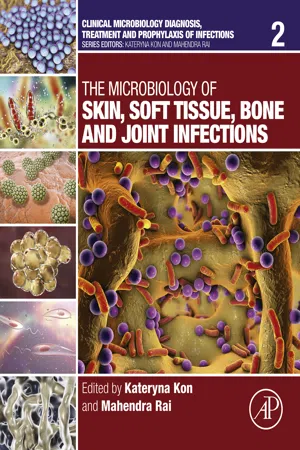
The Microbiology of Skin, Soft Tissue, Bone and Joint Infections
Kateryna Kon,Mahendra Rai
- 338 pages
- English
- ePUB (adapté aux mobiles)
- Disponible sur iOS et Android
The Microbiology of Skin, Soft Tissue, Bone and Joint Infections
Kateryna Kon,Mahendra Rai
À propos de ce livre
The Microbiology of Skin, Soft Tissue, Bone and Joint Infections: Volume 2 discusses modern approaches in diagnosis, treatment, and prophylaxis of skin, soft tissue, bone, and joint infections. The volume has been divided into three sections.
The first section includes chapters on diagnosis, treatment, and prophylaxis of skin and soft tissue infections. It discusses antimicrobial and surgical treatment of wounds, diabetic foot, and different soft tissue infections. Ten chapters are devoted to cutaneous and musculoskeletal infections in special groups of patients, which have their own specificity, i.e. in pediatric and HIV-infected patients. Together with chapters on commonly present diseases, there are chapters which discuss interesting but not well studied pathologies (natal cleft pilonidal sinus) and pathogens (Malassezia and Shewanella spp.).
The second section reviews etiology, pathogenesis, diagnosis and treatment of bone and joint infections, mainly osteomyelitis and prosthetic joint infections. Also, one chapter in this section discusses a newly emerging bacterial pathogen that causes skeletal infections, Kingella kingae. The third section incorporates alternative and new approaches—such as nanotechnology, ultrasound, novel delivery approaches and phyto-derived medicines—to the treatment and prophylaxis of skin, soft tissue, bone, and joint infections.
- Encompasses a broad range of skin, soft tissue, bone, and joint infections, including questions of etiology, pathogenesis, diagnosis, prognosis, treatment, and prophylaxis
- Written by highly professional and eminent surgeons, microbiologists, and infectious disease specialists
- Discusses topics using modern insight, providing all necessary scientific information on each aspect
- Includes scientific understanding and practical guidelines, which make it interesting for both research scientists and practitioners working with skin, soft tissue, bone, and joint infections
Foire aux questions
Informations
Nanotechnology for the Treatment of Fungal Infections on Human Skin
† University of Ljubljana, Ljubljana, Slovenia